- Home Page
- Indoor Kites
- ... Delta Kite
How to Make an Indoor Delta Kite
On this page are a number of easy steps showing you how to make an indoor delta kite from readily available materials.
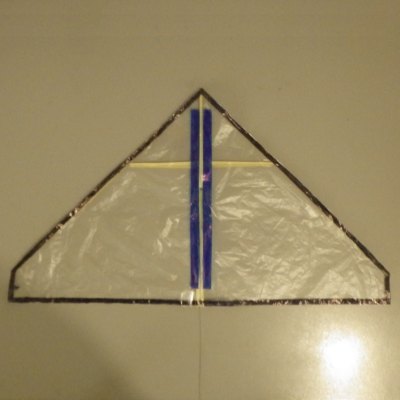 MBK Indoor Delta
MBK Indoor DeltaThe only materials required for this design are:
- One sheet of plain copier paper—A4 or Letter size. Use colored paper if you want to!
- 18 mm (3/4 in.) clear sticking tape, preferably in a dispenser. Narrower tape would be even better if you have it.
- A light plastic bag, at least 45 cm x 30 cm (18 in. x 12 in.) before being cut open. I used large freezer bags.
- Any polyester sewing thread, preferably the lightest available.
The tools required, if you can call them that, are:
- A pair of scissors.
- A ruler.
- A straight edge longer than 45 cm (18 in.).
- A ballpoint pen.
- Colored permanent markers.
Note: In the photos below, yellow lines have been added to make clear where the edges of sticking tape are.
On this site, there's more kite-making info than you can poke a stick at. :-)
Want to know the most convenient way of using it all?
The Big MBK E-book Bundle is a collection of downloads—printable PDF files which provide step-by-step instructions for many kites large and small.
That's every kite in every MBK series.
Step 1—Make Sail
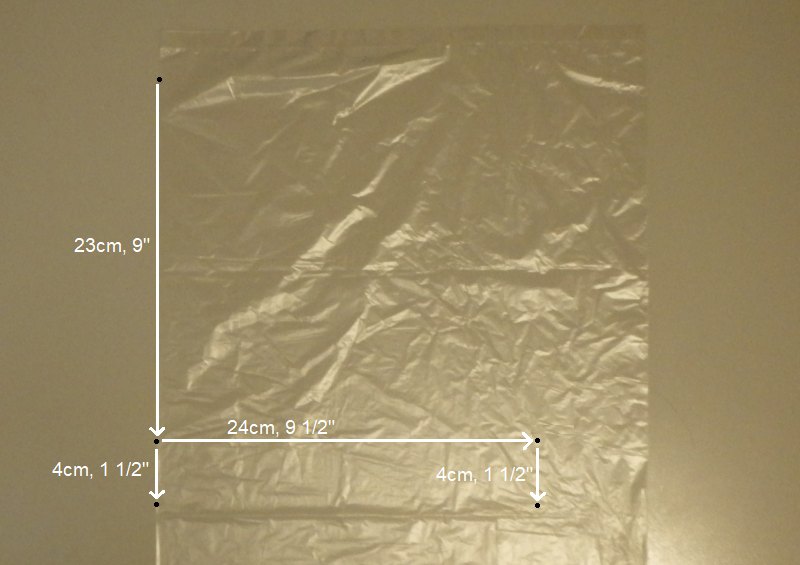 Measured and dots marked
Measured and dots marked- Lay down a plastic bag, and smooth it out to remove the most obvious folds and creases.
- Measure and mark dots as indicated in the photo.
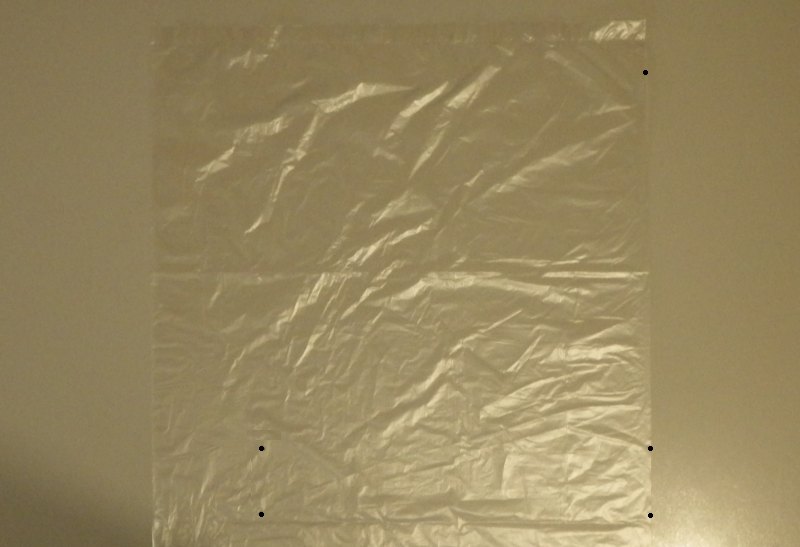 Bag flipped and dots traced
Bag flipped and dots traced- Flip the bag over.
- Mark dots over the two showing through the plastic. See to the left in the photo above.
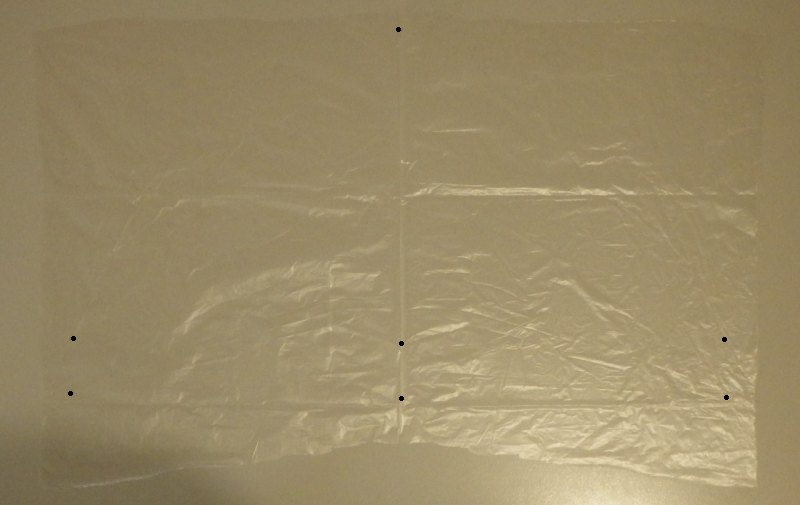 Bag cut and opened out
Bag cut and opened out- Cut the bag along the sealed edge to open it.
- Cut the bag along the opposite side to the side with three dots.
- Open the bag out into a single flat sheet with the dots on top. In the photo, you can see all seven dots.
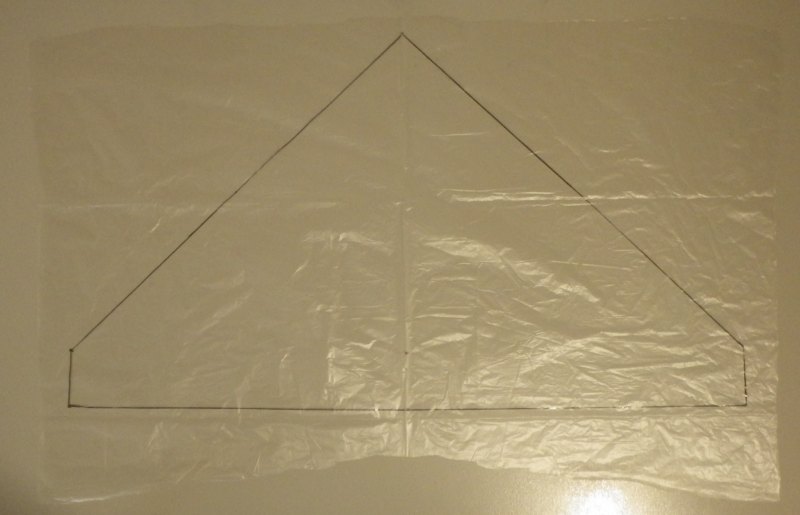 All lines drawn
All lines drawn- Rule lines between six of the dots, as shown, to complete the delta shape.
Step 2—Decorate Sail
Do you have permanent colored markers? It's time to take them out.
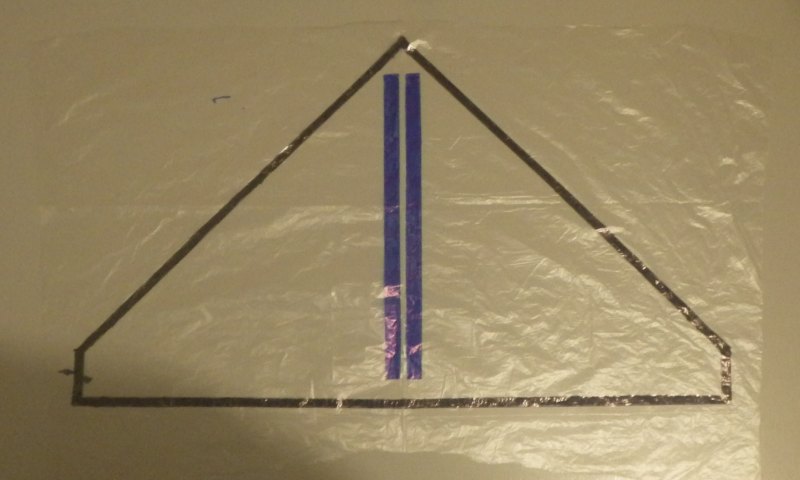 Decorated with permanent markers
Decorated with permanent markers- My approach was to put a 0.6 cm (1/4") wide border of black all around on the inside of the delta outline. This was followed by 1 cm (3/8") wide colored stripes down each side of the centerline, 0.6cm (1/4") apart. See the photo.
- You do whatever you like! Just try not to add too much weight, though. Doing "sparing line art" is how to make an indoor delta kite look good and minimize weight.
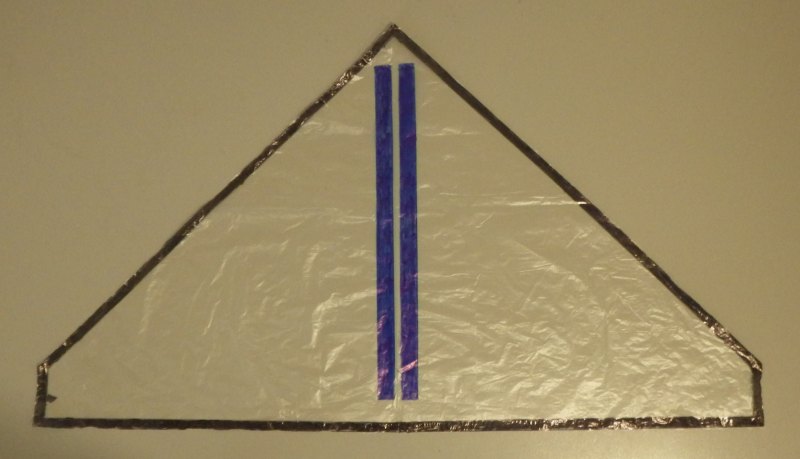 Delta shape cut out
Delta shape cut out- Cut all around the delta shape with scissors. Cutting thin plastic can be tricky, so take your time. Sharp scissors help!
- From here on, we will refer to the plastic piece as the sail.
Step 3—Make Spars
Measure and Draw
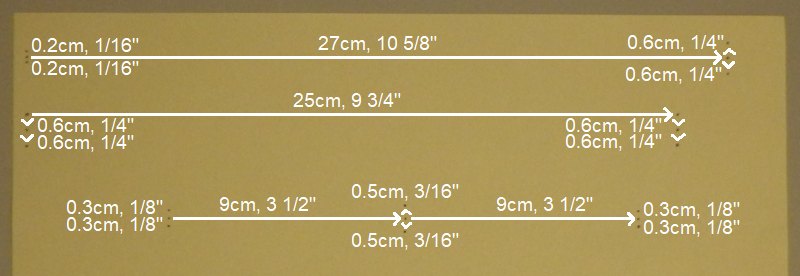 Dots measured and marked
Dots measured and marked- Take your sheet of paper, and mark dots as shown.
Note: Some of the dots were too close together to fit a complete arrow between them on the photo. The measurements show how far to go down (or up) in each case. Easy!
 Lines drawn
Lines drawn- With ruler and pen, connect the dots as shown.
Laminate and Cut Out
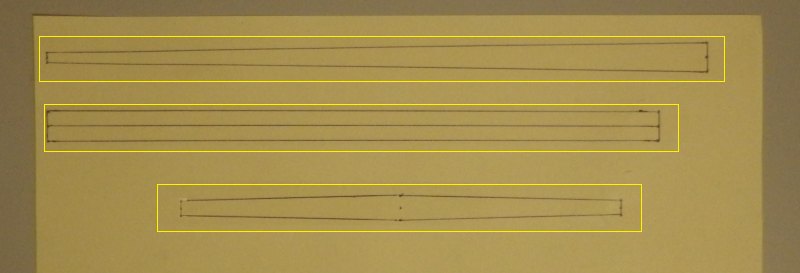 Tape laid down over shapes
Tape laid down over shapes- Lay down sticking tape to fully cover the shapes. A small amount of overlap is OK.
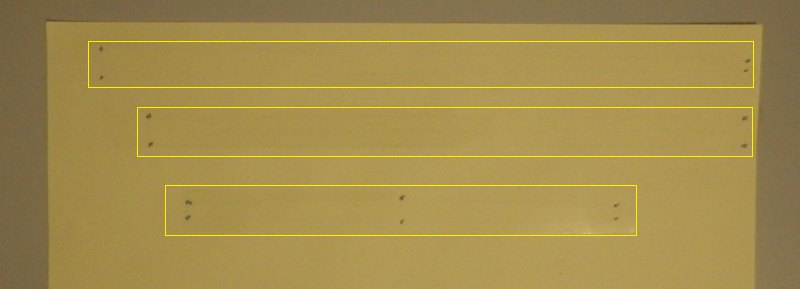 Tape laid down over shapes, reverse side
Tape laid down over shapes, reverse side- Flip the paper over so you can add tape to the reverse side of all the shapes. It might help to place the paper up against a well-lit window to trace the corners. Another way is to poke holes through the paper with a pin at all the corners. Then you can see where all the shapes are.
 Spar pieces cut out
Spar pieces cut out- Cut out all the shapes as shown.
Fold Lengthwise
 Spars folded
Spars folded- Fold all the shapes in half, down their lengths as shown.
- Crease all the folds sharply. The thin ends are tricky, but it can be done! Just do the best you can by working along from the thicker ends, and it should be OK. Pinching between thumbnail and forefinger works well.
- What you have now is a vertical spar (the longest piece), two leading-edge spars (the next longest pieces), and the spreader (the shortest piece). Note that the dot in the middle of the spreader is on the outside of the fold.
At this point, you're about halfway through learning how to make an indoor delta kite! The hardest bits have been done already, I'd say.
Step 4—Attach Spars
Tape Vertical Spar
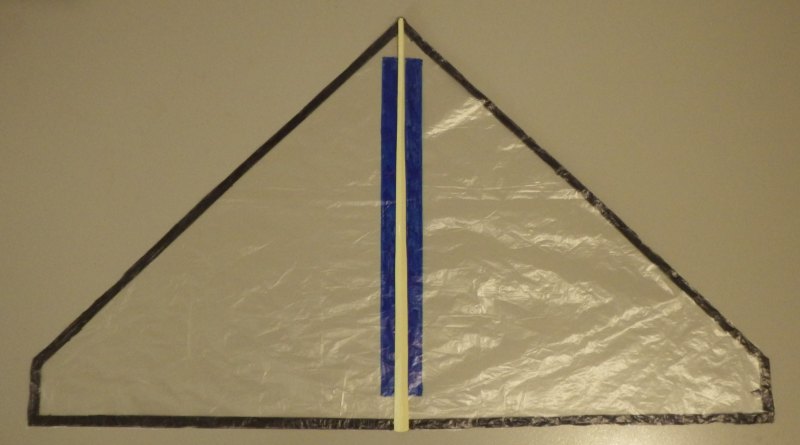 Vertical spar in position
Vertical spar in position- Flip the sail so the art work is against the table.
- Take the vertical spar and align the narrow end to the top corner of the sail. Also ensure the fold angle is 90 degrees or a little less.
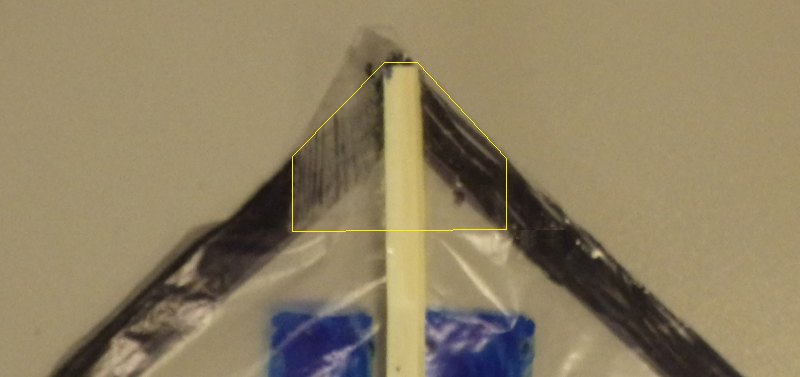 Spar taped on, at nose end
Spar taped on, at nose end- At the top corner of the sail, place a short strip of sticking tape across the fold line of the spar.
- Gently press down on both sides so the tape goes down then across to the left and right.
- With scissors, trim the overhanging tape flush with the sail edges. See the photo.
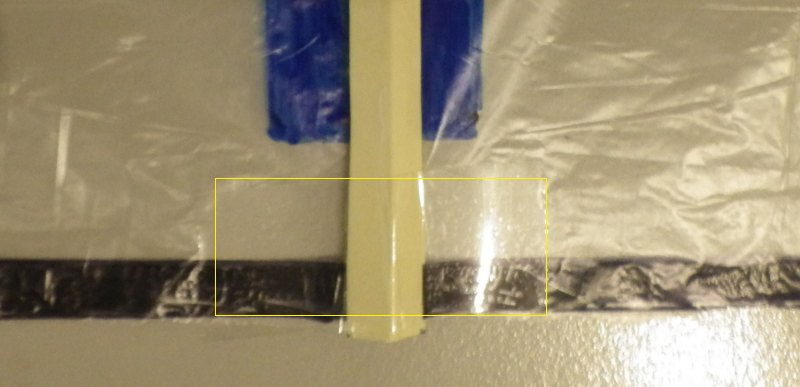 Spar taped on, at tail end
Spar taped on, at tail end- At the bottom corner of the sail, lay down a 4 cm (1 1/2 in.) strip of tape as shown.
- Now lay down another two strips of the same length, right on top of the first one. This is to put a little extra weight there for stability.
- If the spar overhangs a bit, as in the photo, leave it.
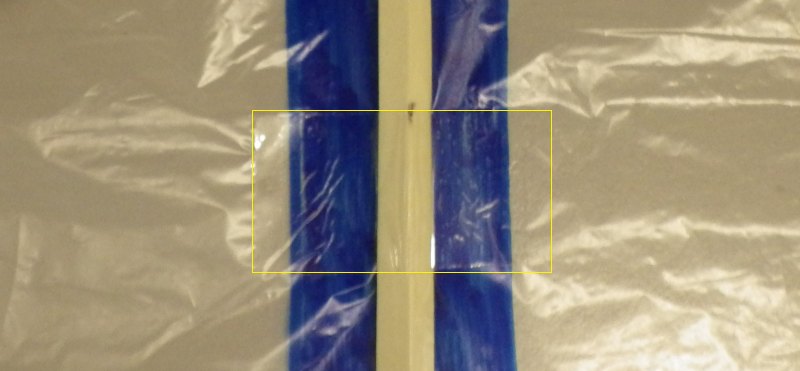 Spar taped behind towing point
Spar taped behind towing point- Measure down from the narrow end of the vertical spar, and make a mark at 12 cm (4 3/4 in.)
- Place a short strip of tape over the spar, lining it up with the mark as shown in the photo. This stops the sail separating from the spar when the kite is being towed.
Tape Leading Edge Spars
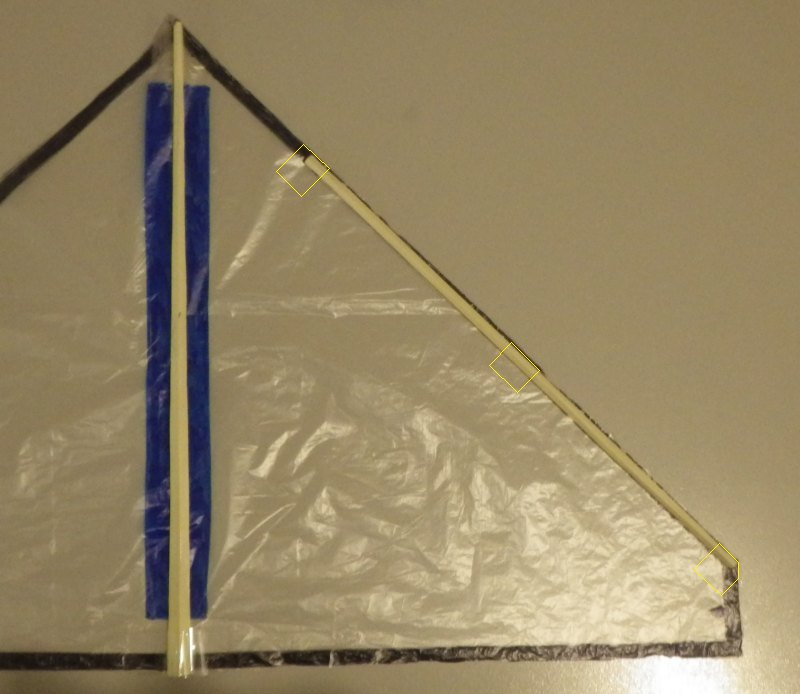 A leading edge spar in position
A leading edge spar in position- In a similar way, lay down a leading edge spar, ensuring the fold angles are 90 degrees or a little less. See how it lines up with the wingtip.
- Apply three squares of tape as shown, trimming along the edge of the sail if any tape overhangs.
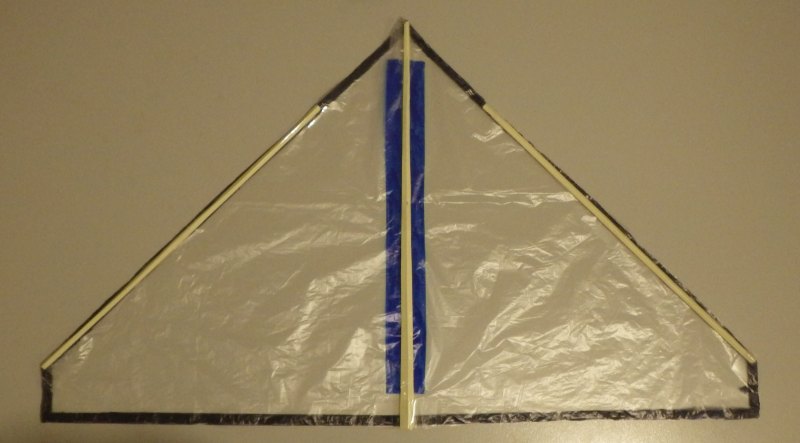 Both leading edge spars taped down
Both leading edge spars taped down- In the same way, tape the other spar in place. See the photo of the whole sail.
Step 5—Attach Spreader
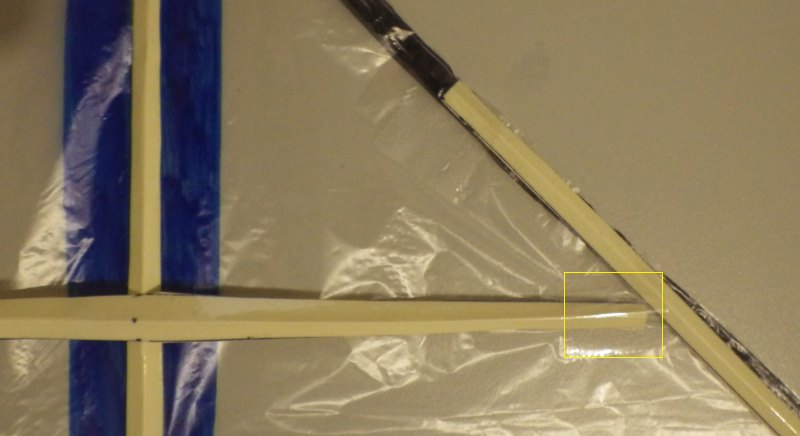 One end of spreader attached
One end of spreader attached- Place the spreader horizontally as shown, aligning the central mark with the fold in the vertical spar.
- Slide the spreader up or down until it just fits between the leading edge spars.
- Stick one end of the spreader onto the sail as shown, using a square of sticking tape. Don't flatten the spreader paper! Just dab the tape down on each side.
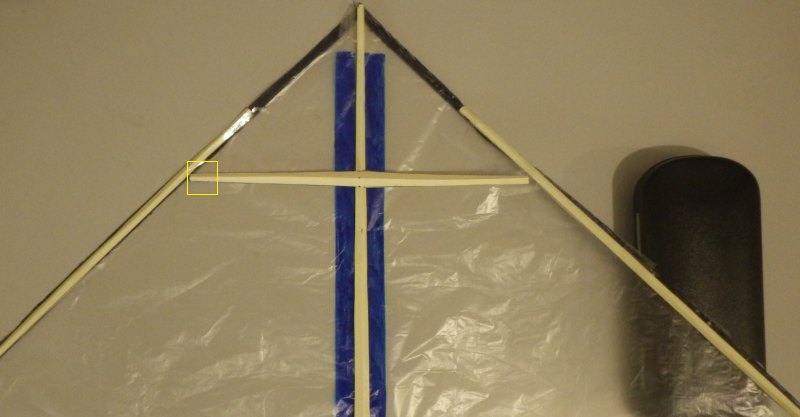 Other end of spreader attached
Other end of spreader attached- Now place some handy object underneath the leading edge, near where you just applied the tape.
- Shift the supporting object until the other spreader tip starts to rest against the sail.
- Gently place a square of sticking tape over the spreader tip so it too is stuck to the plastic.
- Make sure the tape is stuck firmly. Again, be careful not to flatten the fold in the spreader.
Step 6—Attach Flying Line
You have pretty much finished learning how to make an indoor delta kite at this point!
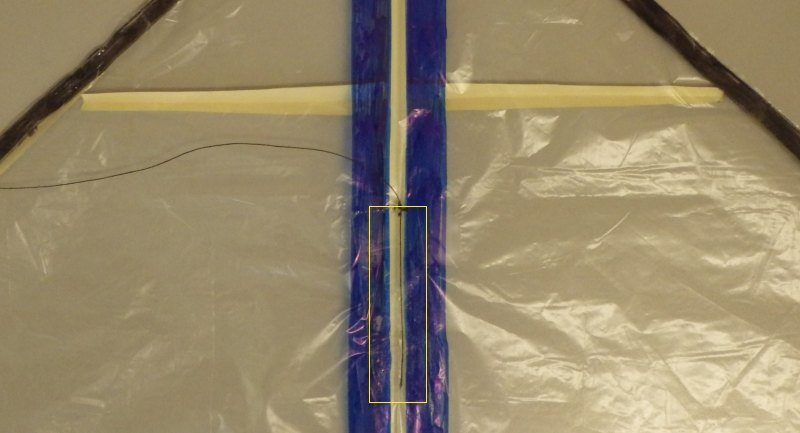 Thread laid down and taped
Thread laid down and taped- Flip the kite over, and mark a dot on the vertical spar, 12.5 cm (5 in.) from the nose end. Try to be accurate here.
- Cut off about 2 m (6 ft.) of polyester sewing thread, and lay one end over the dot.
- Stick down at least 4 cm (1 1/2 in.) of the thread by lining up a similar length of sticking tape with the dot as shown in the photo. Press gently to avoid crushing the paper spars.
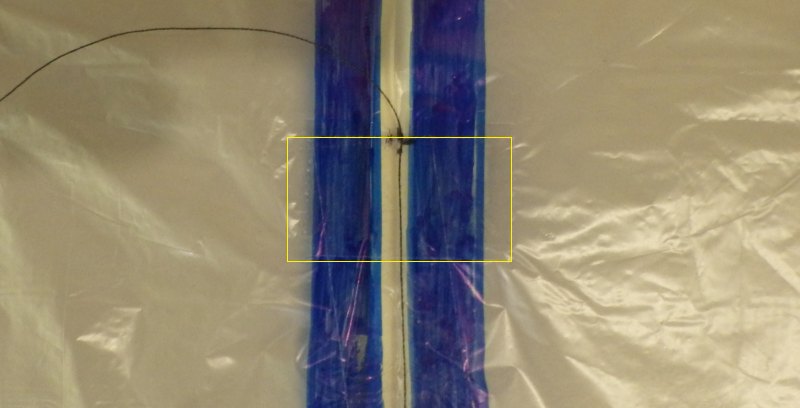 Second bridle tape laid across
Second bridle tape laid across- Add a 3 cm (1 in.) strip of tape crossways as shown in the closeup photo. The kite is ready to fly.
Step 7—Flying!
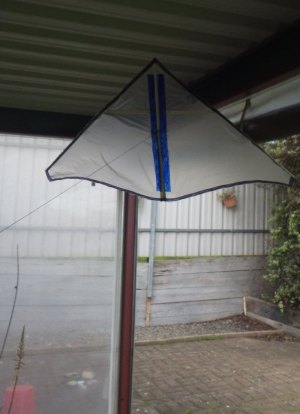 Indoor Delta about to climb away
Indoor Delta about to climb awayThis is a very low-speed kite, and it will effortlessly float up at walking pace. Be careful not to jerk the thread or pull too quickly, since this will promptly fold up at least one of the spars!
If a spar does fold up, don't despair. Just carefully pinch the paper where it failed, to get it back into that V-shape section once again. Then try again, going a little slower or smoother this time.
The Launch Technique
This is how I like to launch on a length of thread equal to your shoulder height:
- Lay the kite flat on the floor, with the thread on top, of course, and the tail end pointing at your feet.
- Lift gently straight up while taking a couple of quick steps backward.
- If the kite appears to be rising, turn around and walk forward while looking back over your shoulder.
- Within seconds, you should see the kite floating behind. Walk a little faster to climb the kite; slow down to descend. It's a fine balance!
If you have the space, try letting out more thread and adjusting your speed until the kite cruises along just short of the ceiling. Look out for light fittings and so on. Look where you're going too from time to time. ;-)
If you need even more line length, just tie on more thread, and wind it onto a small square of cardboard.
I hope you have enjoyed learning how to make an indoor delta kite this way.
As mentioned earlier, there's more kite making on this site than you can poke a stick at. :-)
Want to know the most convenient way of using it all?
The Big MBK E-book Bundle is a collection of downloads—printable PDF files which provide step-by-step instructions for many kites large and small.
That's every kite in every MBK series.
